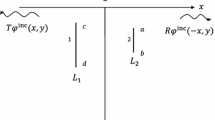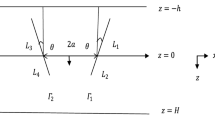Abstract
Water wave scattering by two asymmetric thin elastic plates with arbitrary inclinations is investigated using integral equations. The plates are submerged in finite depth water. The assumption of Euler–Bernoulli beam model for the plates, the use of the appropriate Euclidean transformations to handle the fifth-order plate conditions and the application of Green’s function technique allow us to obtain the expressions of normal velocities at arbitrary points over the plates. On the other hand, an application of Green’s integral theorem on the scattered potential and the source potential functions gives us the alternative expressions of the above-mentioned normal velocities. The comparison of these alternative forms provides two coupled integral equations involving the unknown potential differences across the plates. Kernels of the integral equations have regular as well as hypersingular parts so that the resulting integral equations are hypersingular in nature. These are solved numerically and the solutions are utilized to compute the numerical estimates for different physical quantities. Published results are recovered for different arrangements of the plates and new results are presented graphically for various parametric values.




























Similar content being viewed by others
References
Dean WR (1945) On the reflexion of surface waves by a submerged plane barrier. Proc Camb Philos Soc 41(3):231–238
Ursell F (1947) The effect of a fixed vertical barrier on surface waves in deep water. Proc Camb Philos Soc 43(3):374–382
Evans DV (1970) Diffraction of water waves by a submerged vertical plate. J Fluid Mech 40(3):433–451
Porter D (1972) The transmission of surface waves through a gap in a vertical barrier. Proc Camb Philos Soc 71(2):411–421
Kashiwagi M (2004) Transient responses of a VLFS during landing and take-off of an airplane. J Mar Sci Technol 9(1):14–23
Korobkin AA, Khabakhpasheva TI (2006) Regular wave impact onto an elastic plate. J Eng Math 55(1–4):127–150
Wang CM (2016) VLFS technology for land creation on the sea. In: Mech Struc Mat XXIV, pp 82–93. CRC Press
Meylan MH (2019) The time-dependent vibration of forced floating elastic plates by eigenfunction matching in two and three dimensions. Wave Motion 88:21–33
Meylan MH (1995) A flexible vertical sheet in waves. IJOPE 5(02):105–110
Chakraborty R, Mandal BN (2014) Scattering of water waves by a submerged thin vertical elastic plate. Arch Appl Mech 84(2):207–217
Chakraborty R, Mondal A, Gayen R (2016) Interaction of surface water waves with a vertical elastic plate: a hypersingular integral equation approach. Z Angew Math Phys 67(5):115
John F (1948) Waves in the presence of an inclined barrier. Commun Pure Appl Math 1(2):149–200
Parsons NF, Martin PA (1992) Scattering of water waves by submerged plates using hypersingular integral equations. Appl Ocean Res 14(5):313–321
Parsons NF, McIver P (1999) Scattering of water waves by an inclined surface-piercing plate. Q J Mech Appl Math 52(4):513–524
Gayen R, Mondal A (2016) Water wave interaction with two symmetric inclined permeable plates. Ocean Eng 124:180–191
Kundu S, Gayen R, Datta R (2018) Scattering of water waves by an inclined elastic plate in deep water. Ocean Eng 167:221–228
McIver M (1985) Diffraction of water waves by a moored, horizontal, flat plate. J Eng Math 19(4):297–319
Ren X, Wang KH (1994) Mooring lines connected to floating porous breakwaters. Int J Eng Sci 32(10):1511–1530
Newman JN (2008) Trapping of water waves by moored bodies. J Eng Math 62(4):303–314
Korobkin AA, Khabakhpasheva TI, Malenica S (2016) Deformations of an elastic clamped plate in uniform flow and due to jet impact. In: Proc 31st int workshop water waves float bod, Plymouth, 3–6 April, pp 85–88
Levine H, Rodemich E (1958) Scattering of surface waves on an ideal fluid. Tech rep, Stanford Univ CA Applied Mathematics and Statistics Labs
Jarvis RJ (1971) The scattering of surface waves by two vertical plane barriers. J Inst Maths Appl 7:207–215
Evans DV, Morris CAN (1972) Complementary approximations to the solution of a problem in water waves. IMA J Appl Math 10(1):1–9
Newman JN (1974) Interaction of water waves with two closely spaced vertical obstacles. J Fluid Mech 66(1):97–106
Das P, Dolai DP, Mandal BN (1997) Oblique wave diffraction by parallel thin vertical barriers with gaps. J Waterway Port Coast Ocean Eng 123(4):163–171
Mandal BN, Gayen R (2002) Water-wave scattering by two symmetric circular-arc-shaped thin plates. J Eng Math 44(3):297–309
De S, Mandal BN, Chakrabarti A (2009) Water-wave scattering by two submerged plane vertical barriers—Abel integral equation approach. J Eng Math 65(1):75–87
Morris CAN (1975) A variational approach to an unsymmetric water-wave scattering problem. J Eng Math 9(4):291–300
McIver P (1985) Scattering of water waves by two surface-piercing vertical barriers. IMA J Appl Math 35(3):339–355
Neelamani S, Vedagiri M (2002) Wave interaction with partially immersed twin vertical barriers. Ocean Eng 29(2):215–238
Roy R, Basu U, Mandal BN (2016) Oblique water wave scattering by two unequal vertical barriers. J Eng Math 97(1):119–133
Gupta S, Gayen R (2018) Scattering of oblique water waves by two thin unequal barriers with non-uniform permeability. J Eng Math 112(1):37–61
Gupta S, Gayen R (2019) Water wave interaction with dual asymmetric non-uniform permeable plates using integral equations. Appl Math Comput 346:436–451
Gayen R, Gupta S (2020) Scattering of surface waves by a pair of asymmetric thin elliptic arc shaped plates with variable permeability. Eur J Mech-B 80:122–132
Nik Long NMA, Eshkuvatov ZK (2009) Hypersingular integral equation for multiple curved cracks problem in plane elasticity. Int J Solids Struct 46(13):2611–2617
Zakharov EV, Setukha AV, Bezobrazova EN (2015) Method of hypersingular integral equations in a three-dimensional problem of diffraction of electromagnetic waves on a piecewise homogeneous dielectric body. Differ Equ 51(9):1197–1210
Wang X, Ang WT, Fan H (2018) Effective properties of magnetoelectroelastic interfaces weakened by micro-cracks. Z Angew Math Mech 98(5):727–748
Lifanov IK, Poltavskii LN, Vainikko MGM (2003) Hypersingular integral equations and their applications, vol 4. CRC Press, Boca Raton
Parsons NF, Martin PA (1994) Scattering of water waves by submerged curved plates and by surface-piercing flat plates. Appl Ocean Res 16(3):129–139
McIver P (2005) Diffraction of water waves by a segmented permeable breakwater. J Water Port Coast Ocean Eng 131(2):69–76
Gayen R, Mondal A (2014) A hypersingular integral equation approach to the porous plate problem. Appl Ocean Res 46:70–78
Martin PA, Farina L (1997) Radiation of water waves by a heaving submerged horizontal disc. J Fluid Mech 337:365–379
Farina L, Martin PA (1998) Scattering of water waves by a submerged disc using a hypersingular integral equation. Appl Ocean Res 20:121–134
Nokob MH, Yeung RW (2015) Diffraction and radiation loads on open cylinders of thin and arbitrary shapes. J Fluid Mech 772:649–677
Kundu S, Datta R, Gayen R, Islam N (2019) The interaction of flexural-gravity waves with a submerged rigid disc. Appl Ocean Res 92:101912
Islam N, Kundu S, Gayen R (2019) Scattering and radiation of water waves by a submerged rigid disc in a two-layer fluid. Proc R Soc A 475(2232):20190331
Golberg MA (1983) The convergence of several algorithms for solving integral equations with finite-part integrals. J Integr Equ 5(4):329–340
Golberg MA (1985) The convergence of several algorithms for solving integral equations with finite part integrals. II. J Integr Equ 9(3):267–275
Andrianov A (2005) Hydroelastic analysis of very large floating structures. Doctorale Thesis, Delft University of Technology
Hassan M, Meylan MH, Peter MA (2009) Water-wave scattering by submerged elastic plates. Q J Mech Appl Math 62(3):321–344
Acknowledgements
The authors are thankful to the reviewers for their valuable and insightful comments on the manuscript to improve the same into its present form.
Author information
Authors and Affiliations
Corresponding author
Additional information
Publisher's Note
Springer Nature remains neutral with regard to jurisdictional claims in published maps and institutional affiliations.
Appendix A: Determination of the expressions of \(g_i(Y_i,\overline{Y_i})\)
Appendix A: Determination of the expressions of \(g_i(Y_i,\overline{Y_i})\)
Here we discuss the process of determining the Green’s functions satisfying the boundary value problems given by equations (15) and end conditions (14). Other inherent conditions to be satisfied by these Green’s functions are given as
and
The general solutions of Eq. (15) (for \(i=1,2\)) are of the form
where \(A_{i1},B_{i1}\ldots \) are to be determined. Using end conditions (14) and the inherent properties of the Green’s functions we get the system of equations
Here
where \(\gamma _i=b_i-\overline{Y_i}\). Also, the values of \(A_{2i},B_{2i},C_{2i},D_{2i}\) are found by the relations
Rights and permissions
About this article
Cite this article
Kundu, S., Gayen, R. & Gupta, S. Propagation of surface waves past asymmetric elastic plates. J Eng Math 126, 4 (2021). https://doi.org/10.1007/s10665-020-10076-1
Received:
Accepted:
Published:
DOI: https://doi.org/10.1007/s10665-020-10076-1




